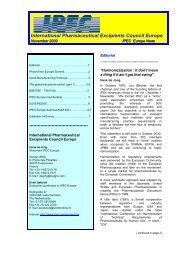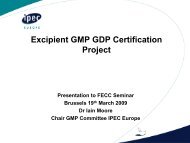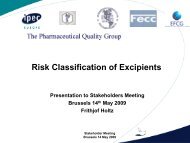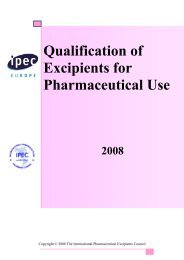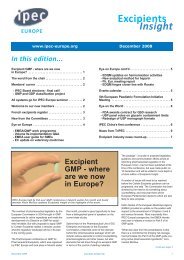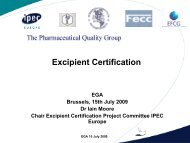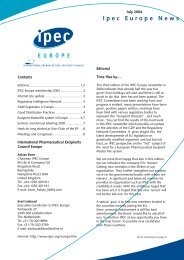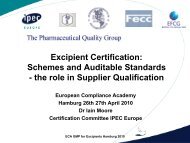Excipients Insight - IPEC Europe
Excipients Insight - IPEC Europe
Excipients Insight - IPEC Europe
Create successful ePaper yourself
Turn your PDF publications into a flip-book with our unique Google optimized e-Paper software.
EUROPE<br />
<strong>Excipients</strong><br />
<strong>Insight</strong><br />
www.ipec-europe.org October 2008<br />
In this edition...<br />
Certification efforts step up . . . . . . . . . . . . . . . . . .page 1<br />
The word from the chair . . . . . . . . . . . . . . . . . . . . page 2<br />
Board updates . . . . . . . . . . . . . . . . . . . . . . . . . . . . page 2<br />
- 2009 AGM and seminar<br />
- Board elections<br />
US seeks country-of-origin labelling . . . . . . . . . . page 2<br />
News from the <strong>IPEC</strong> Committees . . . . . . . . . . . . page 3<br />
- Harmonization Committee<br />
- GMP Committee<br />
- Regulatory Affairs Committee<br />
- GDP Committee<br />
Push for allergen labelling . . . . . . . . . . . . . . . . . . page 3<br />
Heparin update . . . . . . . . . . . . . . . . . . . . . . . . . . . page 3<br />
Eye on <strong>Europe</strong> . . . . . . . . . . . . . . . . . . . . . . . . . . . . page 4<br />
- Radiopharmaceuticals GMP regulation<br />
- PharmEuropa: new edition published<br />
- EDQM advises on Certificates of Suitability<br />
- Triethanolamine status change<br />
<strong>IPEC</strong> conferences in profile . . . . . . . . . . . . . . . . . page 4<br />
REACH deadline approaches - are you ready? . . . page 4<br />
Eye on the World . . . . . . . . . . . . . . . . . . . . . . . . . page 5<br />
- Bid to resolve residual solvent confusion<br />
- ICH November meeting and agenda<br />
- Latest developments at WHO<br />
<strong>IPEC</strong> Americas conference report . . . . . . . . . . . page 5<br />
<strong>IPEC</strong> China elects chair . . . . . . . . . . . . . . . . . . . . page 5<br />
TriPEC updates . . . . . . . . . . . . . . . . . . . . . . . . . . page 5<br />
Science and Technology . . . . . . . . . . . . . . . . . . . page 6<br />
- FDA seeks input on nanotechnology guidance<br />
- Quality by Design for inhaled and intranasal drugs<br />
Events Calendar . . . . . . . . . . . . . . . . . . . . . . . . . . page 6<br />
Excipient industry news . . . . . . . . . . . . . . . . . . . page 7<br />
- Pfizer API unit to use Prosonix’<br />
- Beneo-Palatinit introduces filler/binder<br />
- Novozymes wins gold with hyaluronic acid<br />
- ISP adds to range of pharmaceutical coatings<br />
- Univar’s chlorhexidine gluconate gets CEP<br />
- Dow working to restore PEG capacity<br />
<strong>IPEC</strong>, EFCG move certification<br />
project forward<br />
Efforts to advance the creation of a pan-<strong>Europe</strong>an<br />
certification programme for excipients are<br />
now gaining momentum. In the latest development,<br />
<strong>IPEC</strong> <strong>Europe</strong> and the <strong>Europe</strong>an Fine<br />
Chemicals Group have formed a <strong>Europe</strong>an Pharmaceutical<br />
<strong>Excipients</strong> Certification Project to<br />
bring the process forward.<br />
A early objective is to create a ‘certifiable<br />
standard’, expanding on earlier work by <strong>IPEC</strong><br />
<strong>Europe</strong> and the Pharmaceutical Quality Group<br />
(PQG) in setting good manufacturing practice<br />
(GMP) and good distribution practice (GDP)<br />
standards.<br />
<strong>IPEC</strong> <strong>Europe</strong>, <strong>IPEC</strong> Americas, and PQG agreed<br />
in September to set up Steering Committee with<br />
the purpose to draft an international standard for<br />
excipients, based on the <strong>IPEC</strong>/PQG <strong>Excipients</strong><br />
GMP guide, and on ISO 9001:2000 requirements.<br />
The discussion will start with a conference<br />
call this month.<br />
“The standard will be supported by an internationally<br />
recognised certification scheme for excipient<br />
suppliers, an approach which indicators show is<br />
favoured by Industry and regulators,” said <strong>IPEC</strong><br />
<strong>Europe</strong> and EFCG in a joint statement.<br />
Certified<br />
Although the project remains in the early stages,<br />
the objective is that certification would create a<br />
system whereby excipient suppliers could become<br />
accredited by third-party organisations. Ideally, the<br />
accreditation groups would in turn be endorsed<br />
by regulatory authorities. This is consistent with<br />
<strong>IPEC</strong> and PQG's promotion of the use of voluntary<br />
guidance through the implementation of an<br />
appropriate quality system, rather than legislation<br />
which cannot be enforced because of the unique<br />
diversity of the excipients' industry.<br />
The contaminated glycerin and heparin cases<br />
have put the industry under the spotlight. Even<br />
though these events are exceedingly rare, it is<br />
important that <strong>IPEC</strong> <strong>Europe</strong> and other groups<br />
demonstrate that the industry is proactive in its<br />
approach to product quality.<br />
It is anticipated that in <strong>Europe</strong> the certification<br />
scheme will be run by EFCG in conjunction with<br />
<strong>IPEC</strong> <strong>Europe</strong>, with <strong>IPEC</strong> Americas adopting a<br />
similar approach in its home territories. Certification<br />
of manufacturers and distributors would contribute<br />
to the overall assurance of excipient quality,<br />
sought by regulators of medicines and their<br />
manufacturers.<br />
The initiative is complementary to and supports<br />
the collaboration that <strong>IPEC</strong> <strong>Europe</strong> has<br />
undertaken with EFCG to promote a Certification<br />
Programme for excipient manufacture in<br />
<strong>Europe</strong>.<br />
October 2008 www.ipec-europe.org 1
Board Updates<br />
2009 AGM and Seminar<br />
Preparations are now in full swing for the <strong>IPEC</strong><br />
<strong>Europe</strong> Annual General Meeting and Seminar,<br />
which will be held on the morning of 23 January<br />
2009 at the Majestic Hotel in Cannes.<br />
New <strong>IPEC</strong> <strong>Europe</strong> Members will be introduced<br />
and welcomed, and the Board and the Committees'<br />
chairs will report on the Activities and<br />
Objectives achieved in 2008 and those planned<br />
for 2009. Three new Board Members will be<br />
elected in the course of the AGM (see below).<br />
A financial update will be given and approval of<br />
the 2009 budget will be sought by members' representatives.<br />
An update on TriPEC activities will<br />
also be made.<br />
Board Elections<br />
Autumn is now well and truly upon us, and with<br />
the summer fast receding into distant memory<br />
many of us will now be in the midst of another<br />
conference season.<br />
Some of you may have attended the CPhI exhibition<br />
in Frankfurt, which gave a perfect<br />
opportunity to announce progress<br />
in our collaboration with EFCG on the<br />
development of a certifiable standard<br />
and certification programme for excipients.<br />
This important topic is the subject<br />
of our lead article this month.<br />
<strong>Excipients</strong> <strong>Insight</strong> also covered other<br />
pertinent news from the show and you<br />
can see a number of new developments concerning<br />
excipients in the pages of this edition.<br />
It is home-grown conferences that head the<br />
menu for <strong>IPEC</strong> <strong>Europe</strong> in the coming months,<br />
however, with three major events in the calendar.<br />
First up is the TriPEC meeting in November will<br />
once again coincide with the biannual ICH conference<br />
and provide a great opportunity for<br />
The word from the chair<br />
TriPEC members to interact with their peers in<br />
the Pharmaceutical Development Group.<br />
Shortly after that we have the conference on<br />
GMP for excipients, which will take place 1-2<br />
December. More details are available on page 4<br />
of this issue. This conference features<br />
an outstanding speaker panel from international<br />
regulatory bodies and industry,<br />
and represents a truly unique opportunity<br />
for discussing developments and initiatives<br />
of the major stakeholders.<br />
Last but not least we have our annual<br />
AGM and seminar in January 2009.<br />
You can see the breadth of our seminar<br />
programme on page 4.<br />
I hope you find this edition useful, and look forward<br />
to greeting you all in person in the coming<br />
months.<br />
On behalf of <strong>IPEC</strong> <strong>Europe</strong> Board,<br />
Patricia Rafidison<br />
US bill seeks countryof-origin<br />
labelling<br />
Chair to <strong>IPEC</strong> <strong>Europe</strong><br />
As you may be aware the term of office of Board<br />
Directors is three years renewable. In 2009,<br />
three of the Board Directors will be ending their<br />
term:<br />
O Patricia Rafidison, Dow Corning (Manufacturer)<br />
O Adrian L. Bone, Eli Lilly (User)<br />
O Michel Malandain, Seppic (Manufacturer)<br />
As a result there three positions will become<br />
available within the Board of Directors.<br />
According to the Article 10 of the <strong>IPEC</strong> by-laws,<br />
an election has to be organised. At least two representatives<br />
of the two groups represented within<br />
<strong>IPEC</strong> <strong>Europe</strong>; i.e. users and manufacturers, have<br />
to be nominated candidate for the Board of<br />
Directors.<br />
All the nominations must be submitted by email<br />
or fax to the <strong>IPEC</strong> <strong>Europe</strong> Secretariat by 5 January<br />
2009 at the latest.<br />
Email: info@ipec-europe.org<br />
Fax: +32 2 732 34 37<br />
The vote will be organised at the Annual General<br />
Meeting on 23 January 2009 and the newly<br />
Directors shall take their function at the following<br />
Board meeting after the AGM.<br />
A bill has been introduced to the US Senate<br />
that would require the country-of-origin of<br />
pharmaceutical ingredients to be labeled on<br />
finished dosage forms.<br />
This proposal covers both active pharmaceutical<br />
ingredients (APIs) and excipients present<br />
in prescription or over-the-counter (OTC)<br />
products.<br />
Including excipients under the<br />
bill differentiates it from the proposal<br />
in the draft of the US Food<br />
and Drug Administration Globalization<br />
Act, which was released<br />
in April.<br />
Under the proposal the country-of-origin of<br />
each active and inactive ingredient would be<br />
listed in descending order based upon the<br />
quantity in the finished dose.<br />
It appears that it will not be necessary to<br />
include the country of origin of all raw materials<br />
and intermediates, or the nation in which<br />
every step in the synthesis process occurs.<br />
This would provide a more comprehensive<br />
view of the origins of an API or excipient but is<br />
not mentioned in the bill, probably due to the<br />
complexity of implementing such a measure.<br />
Having been read twice in the Senate the bill<br />
has been referred to the Committee on<br />
Health, Education, Labor, and Pensions.<br />
If implemented, the bill will take effect 180<br />
days after the legislature agrees to enact it.<br />
With the presidential election taking place,<br />
and the current focus on militating against the<br />
looming recession, the bill is<br />
unlikely to be agreed upon in<br />
2008.<br />
Consequently its implementation<br />
rests largely on the political<br />
agenda of the new regime and<br />
how other issues develop in the<br />
coming months. The bill can be found here.<br />
The bill has been put forward by Senator Sherrod<br />
Brown (Democrat – Ohio), who in recent<br />
months has called for the FDA to launch a probe<br />
into pharmaceutical outsourcing.<br />
Brown has raised concerns over the safety of<br />
pharmaceutical products and the level of outsourcing,<br />
writing letters to Pfizer and Merck &<br />
Co requesting information on their use of<br />
third-parties.<br />
This excerpt of a longer article is provided<br />
courtesy of www.in-PharmaTechnologist.com.<br />
2 www.ipec-europe.org October 2008
News from the <strong>IPEC</strong><br />
committees<br />
Harmonization Committee<br />
The last meeting was held on 10 September, in Strasbourg, France. The minutes will be published in<br />
the member’s area of the <strong>IPEC</strong> <strong>Europe</strong> website once available.<br />
Some of the main issues the Harmonization Committee is currently working on include the following:<br />
- Silica monographs.<br />
- Monograph on crospovidone.<br />
- Carmellose, Hydroxy-Propyl-Cellulose, and Ethyl-Cellulose.<br />
The next meeting will be held on 30 October at Beneo-Palatinit in Mannheim.<br />
If you are interested in participating in Harmonisation Committee activities, please contact the chair,<br />
George Mansveld, or the vice-chair, Bernhard Fussnegger.<br />
GMP Committee<br />
The Excipient Qualification Guide is now in pre-publication, which is a fantastic achievement. The<br />
GMP Committee chair, Iain Moore, would like to thank everyone who contributed to this document. As<br />
soon as it is finalised it will be available in pdf format and circulated to members.<br />
The initial meetings on the certification project (see page 1) have been held and arrangements are<br />
being made to allow working parties to form and start work.<br />
The next meeting will be held on 17 November at the ECCO offices in Brussels.<br />
If you are interested in participating in GMP Committee activities, please contact the chair Iain Moore.<br />
Regulatory Affairs Committee<br />
Once again the key topic for the Regulatory Affairs Committee has been the poposed <strong>Europe</strong>an Master<br />
Files for Novel <strong>Excipients</strong> and Biological/ Biotehnological Active Substances. On 6 October an<br />
<strong>IPEC</strong> <strong>Europe</strong> delegation (Kate Denton/Novozymes, Johann-Philipp Hebestreit/BASF, and Elena<br />
Miceli/Secretariat) met with a delegation of the Pharmaceutical Unit at DG Enterprise of the <strong>Europe</strong>an<br />
Commission.<br />
The aim of the meeting was to communicate <strong>IPEC</strong> <strong>Europe</strong>’s concerns and the difficulties faced by excipient<br />
companies in <strong>Europe</strong> compared to other world areas due to the lack of an excipient master file system.<br />
Ideas were exchanged and proposals put forward to address this issue. The Commission has<br />
asked for practical examples to illustrate where such a system is needed and also requested that <strong>IPEC</strong><br />
<strong>Europe</strong> involve the EMEA in this discussion.<br />
The next meeting will be held on 17 November.<br />
If you are interested in participating in GMP Committee activities, please contact the chair, Carl Mroz.<br />
GDP Committee<br />
The last meeting was held on 5 September and the minutes are available on our website.<br />
Work has continued on the harmonisation of the audit guide with <strong>IPEC</strong> Americas. US distributors comply<br />
with the national system of the National Association of Chemical Distributors (NACD), and it is proposed<br />
that NACD and the <strong>Europe</strong>an Association of Chemical Distributors (EACD) could collaborate to<br />
develop a common transatlantic document. For countries where no such auditing tools are available, a<br />
master guideline based on the GDP guideline could be applied.<br />
The next committee meeting will be held 6 November in Barcelona.<br />
If you are interested in participating in GDP Committee activities, please contact the chair<br />
Allan Whiston.<br />
Pushing for allergen<br />
labelling<br />
Few consumers are aware that many medicines<br />
contain excipients derived from known allergens<br />
or are produced in facilities where allergens may<br />
be present, according to an article published in<br />
Pharmaceutical Technology <strong>Europe</strong>.<br />
Allergies are not dosedependent<br />
and individuals<br />
exhibit different sensitivity at<br />
different occasions, making it<br />
impossible to set a maximum<br />
exposure level similar to that<br />
of toxic chemicals.<br />
There are strict requirements<br />
for labelling pharmaceuticals, but some believe<br />
that sufficient allergy-related information is<br />
already provided in the package leaflet.<br />
The labelling requirements for the food industry<br />
have helped strengthen control of the supply<br />
chain; it is possible that similar legislation for<br />
pharmaceuticals could offer the same benefit,<br />
according to the authors.<br />
Recently, the Australian Allergen Bureau said<br />
the pharmaceutical industry should be obliged to<br />
label key allergens on outer packaging. If the<br />
agency is successful in this campaign then the<br />
process could be introduced in other countries.<br />
This article excerpt has been reproduced with<br />
grateful thanks to Pharmaceutical Technology<br />
<strong>Europe</strong><br />
Heparin scandal prompts<br />
workshop on quality<br />
A workshop jointly organised by the <strong>Europe</strong>an<br />
Directorate for the Quality of Medicines, the<br />
National Institute for Biological Standards and<br />
Control (NIBSC) in the UK and the US Pharmacopeia<br />
was held earlier this year in Strasbourg,<br />
France, to discuss the characterisation and<br />
quality control of heparin.<br />
Earlier this year a contaminant sourced to a<br />
Chinese factory was found in heparin supplies<br />
in 11 countries, prompting widespread product<br />
recalls.<br />
Sessions at the workshop covered the current<br />
situation and perspectives, global harmonization,<br />
and low molecular weight heparin. It paid<br />
special attention on the need to ensure traceability<br />
of raw materials and the control of the<br />
supply chain. The Australian authority pointed<br />
out the need for GMP at all stages.<br />
A summary document, available here, notes<br />
"the supply chain of heparin was a critical step<br />
in the production of heparin and therefore a<br />
potential way for contamination of batches."<br />
More recently, questions have been raised concerning<br />
the potential risk from products where<br />
heparin may have been used in manufacturing<br />
or is present in the final product. These include<br />
plasma-derived clotting factors and other<br />
plasma-derived products such as immune globulins<br />
and albumin. The FDA has advised that<br />
these products are likely to be very low risk.<br />
October 2008 www.ipec-europe.org 3
A look ahead to <strong>IPEC</strong><br />
<strong>Europe</strong> conferences<br />
<strong>Europe</strong>an Commission finalises changes to<br />
radiopharmaceuticals GMP<br />
Revised good manufacturing practice (GMP)<br />
requirements for the production of radiopharmaceuticals<br />
have been published by the <strong>Europe</strong>an<br />
Commission.<br />
The updates to Volume 4 - EU GMP guide -<br />
Annex 3 are intended to make it compliant with<br />
GMP Part II, which laid out additional requirements<br />
for active substances used as starting<br />
materials. The aim is to provide the necessary<br />
regulation to prevent cross-contamination, the<br />
spread of radioactive material and ensure the<br />
quality of the product.<br />
Eye on <strong>Europe</strong><br />
EDQM notes deficiencies in Certificates of<br />
Suitability<br />
The <strong>Europe</strong>an Directorate on the Quality of Medicines<br />
has continued its efforts to improve the content<br />
of applications for Certificates of Suitability<br />
(CEP) for chemical purity.<br />
To that end, the EDQM has issued a document<br />
summarising the main deficiencies found in CEP<br />
dossiers assessed between October and December<br />
2007.<br />
The documents list five top deficiencies and five<br />
points that are not frequently appropriately documented.<br />
The top deficiencies were:<br />
<strong>IPEC</strong> <strong>Europe</strong>’s much anticipated Conference<br />
on GMP for <strong>Excipients</strong>, will be held on 1-2<br />
December 2008 in Munich, Germany.<br />
This is a timely and critical conference, as<br />
GMP has been brought to the fore in light of<br />
public health cases where substandard quality<br />
or counterfeited excipients have been<br />
involved. And of course, the <strong>Europe</strong>an regulatory<br />
environment for GMP for ‘Certain <strong>Excipients</strong>’<br />
remains up in the air.<br />
<strong>IPEC</strong> <strong>Europe</strong> is delighted to welcome a prestigious<br />
panel of speakers, including Sabine Atzor<br />
of the <strong>Europe</strong>an Commission, Katrin Nodop of<br />
the EMEA, Bronwyn Phillips of the UK Medical<br />
and Healthcare products Regulatory Agency<br />
(MHRA) and Steven Wolfgang and Edwin Riviera<br />
from the US Food and Drug Administration<br />
(FDA).<br />
They will be joined by a number of leading lights<br />
from industry.<br />
<strong>Excipients</strong> are also covered in the document,<br />
which is due to come into effect by 1 March<br />
2009.<br />
As reported in the 'Documentation' section,<br />
"Specifications should be established and documented<br />
for raw material, labeling and packaging<br />
materials, critical intermediates and the finished<br />
radiopharmaceutical."<br />
Samples of starting materials, excluding solvents<br />
gases or water used in the manufacturing<br />
process must be kept for at least two years after<br />
the release of the product. This period can be<br />
shortened if the material has a period of stability<br />
of less than two years.<br />
The full document is available here.<br />
EMEA changes triethanolamine status in<br />
veterinary medicines<br />
The <strong>Europe</strong>an Medicines Agency has added triethanolamine<br />
to the list of residue substances<br />
deemed not to have any pharmacologic activity<br />
in veterinary medicinal products.<br />
The list - Annex II of Council Regulation (EEC)<br />
No 2377/90 - was drawn up to identify substances<br />
for which requirements to meet maximum<br />
residue limits (MRLs) do not apply. More<br />
information can be found here.<br />
Triethanolamine is used as an excipient in<br />
creams, lotions and other topical preparations,<br />
and serves as an alkalizing agent, emulsifier and<br />
solubiliser.<br />
Pharmeuropa 20.4 (October 2008)<br />
published<br />
The latest edition of EDQM’s quarterly Pharmeuropa<br />
journal was published earlier this month.<br />
It includes draft monographs and general texts<br />
for comment by 31 December. The list of contents<br />
is available here and it includes "Heavy<br />
Metals 2.4.8".<br />
O the absence of any discussion on genotoxic<br />
impurities;<br />
O the absence of any discussion on the carryover<br />
of impurities/by-products from starting<br />
materials;<br />
O the absence of any discussion on benzene<br />
as a contaminant in identified solvents;<br />
O the absence of any discussion on for starting<br />
materials from different suppliers; and<br />
O absent information on the specifications of<br />
the declared starting materials.<br />
An earlier analysis was published on the EDQM’s<br />
website in December 2006. Encouragingly,<br />
“improvement has been observed in the quality of<br />
the dossiers submitted since that time,” according<br />
to the report.<br />
The working document is available here.<br />
As REACH deadline rolls ever nearer - are you ready?<br />
With the deadline for pre-registration of chemicals<br />
under the <strong>Europe</strong>an Union’s new REACH<br />
legislation coming up on 1 December, readers<br />
are reminded that excipients and active pharmaceutical<br />
ingredients are not necessarily exempt<br />
from the process.<br />
While APIs and excipients do not come under the<br />
auspices of REACH - short for (Regulation for<br />
Registration, Evaluation, Authorisation and<br />
Restriction of Chemicals - they will need to be<br />
pre-registered (and registered) if they are used in<br />
any other applications, such as cosmetics.<br />
Given the fragmented and frankly indefinable<br />
excipient industry, that seems a tall order. Thankfully,<br />
help is at hand.<br />
CEFIC, the <strong>Europe</strong>an Chemical Industry Council,<br />
launched ReachLink, together with five national<br />
chemical associations (France, Germany, Italy,<br />
Spain, and the UK). The purpose of this project is<br />
to assist companies in participating in the Substance<br />
Information Exchange Forum (SIEF).<br />
For more information on this unique conference<br />
visit <strong>IPEC</strong> <strong>Europe</strong>’s website. The programme is<br />
available as a pdf download.<br />
In addition, the annual full-day <strong>IPEC</strong> <strong>Europe</strong><br />
seminar will be held at the Hotel Majestic<br />
Barriere in Cannes on 22 January 2009. The<br />
draft programme includes the following topics:<br />
O Update on pharmacopeia objectives;<br />
O Supply chain - import control in the US;<br />
O GMP update and certification;<br />
O Update on paediatric formulation; and<br />
O Expectations and needs on excipient manufacturing<br />
in relation to quality by design.<br />
A Cocktail and Dinner will then be offered after<br />
the main event.<br />
SIEF’s aims are: data sharing for REACH registration;<br />
collaboration between registrants on the<br />
joint submission of data in the Technical dossier;<br />
and, agreement on substance classification and<br />
labelling.<br />
Under REACH, around 30.000 substances have<br />
to be registered by 2018 with ECHA, the <strong>Europe</strong>an<br />
Chemicals Agency. All companies importing<br />
or manufacturing chemical substances in quantities<br />
above 1 tonne have to submit registration<br />
dossiers.<br />
4 www.ipec-europe.org October 2008
<strong>IPEC</strong> Americas regulatory<br />
affairs conference feedback<br />
Eye on the world<br />
Carl Mroz, chair of <strong>IPEC</strong> <strong>Europe</strong>’s Regulatory<br />
Affairs Committee, attended the <strong>IPEC</strong> Americas<br />
Regulatory Affairs Conference held in Alexandria,<br />
US, on September 15-16.<br />
FDA’s OGD offers to help firms comply with<br />
residual solvents rule<br />
The US Food and Drug Administration has<br />
offered additional advice to generic drug manufacturers<br />
to help them comply with the new US<br />
Pharmacopeia standard for controlling residual<br />
solvents, which came into effect on 1 July.<br />
The FDA’s Office of Generic Drugs (OGD) has<br />
made the move after seeing a lot of variability in<br />
submitted applications. That in turn has led to a<br />
number of deficiency letters regarding compliance<br />
with chapter of the standard.<br />
However, the FDA has interpreted this new<br />
chapter in a way which many feel is inconsistent<br />
with the intention of the USP and the ICH<br />
guidance.<br />
As a result an informal coalition of interested parties,<br />
including <strong>IPEC</strong> <strong>Europe</strong>, has been formed to<br />
address this issue directly with the FDA. The<br />
coalition, which is coordinated by <strong>IPEC</strong> Americas,<br />
had its first meeting with FDA on 10 October.<br />
Additional details will be provided on this<br />
important issue in future editions of <strong>Excipients</strong><br />
<strong>Insight</strong>.<br />
The request implies that all generic companies<br />
must be testing their excipients for residual solvents<br />
and that excipient manufacturers must<br />
include residual solvent specifications on their<br />
Certificates of Analysis (CoAs).<br />
As reported in the August-September <strong>Excipients</strong><br />
<strong>Insight</strong>, FDA published a draft Guidance<br />
document for comment which advises on the<br />
testing that is required. The OGD has published<br />
a new document that provides additional<br />
information on its own expectations.<br />
This document helps clarify some issues but it<br />
is not completely exhaustive.<br />
The US Pharmacopeia has also published a<br />
webpage that provides a portal for all relevant<br />
information and resources available to help drugmakers<br />
conform to the USP standard for residual<br />
solvents here.<br />
International Conference on<br />
Harmonization<br />
The International Conference on Harmonization’s<br />
Steering Committee and Expert Working Groups<br />
is scheduled to meet on 10-13 November. On<br />
this occasion the conference will be held in<br />
<strong>Europe</strong> (Brussels, Belgium).<br />
A public meeting will be also held on 14 November,<br />
to inform on recent developments at ICH<br />
and to receive the latest news on hot topics coming<br />
out of the working groups, to make and to<br />
raise questions on quality , safety, standards<br />
development and efficacy topics.<br />
October 2008<br />
Committee on Specifications for<br />
Pharmaceutical Preparations<br />
The World Health Organization (WHO) Expert<br />
Committee on Specifications for Pharmaceutical<br />
Preparations was scheduled to meet at the<br />
WHO headquarters in Geneva, on 13-17<br />
October, as this edition of <strong>Excipients</strong> <strong>Insight</strong><br />
went to press.<br />
On the agenda for discussion are: quality control;<br />
GMP; quality assurance; and guidance on paediatric<br />
medicines. More information is available<br />
here.<br />
The following documents were circulated for discussion<br />
in advance of the CSPP meeting:<br />
O WHO Guideline on transfer of technology<br />
A specific paragraph of the section on "production"<br />
is dedicated to excipients.<br />
O Recommendations for Improvement of the<br />
WHO Certification Scheme on the Quality of<br />
Pharmaceutical Products Moving in International<br />
Commerce<br />
<strong>Excipients</strong> are involved in the direct export from<br />
manufacture to importing country, as well as<br />
trade involving several manufacturers.<br />
O Draft stability testing of active pharmaceutical<br />
ingredients and finished pharmaceutical<br />
products<br />
This draft proposes that stability studies<br />
should include the interaction of API with<br />
excipients.<br />
O Procedure for prequalification of medicinal<br />
products<br />
The procedure stipulates that specifications for<br />
excipients should be submitted for the finished<br />
product.<br />
World Health Organization makes Ph. Int<br />
available online<br />
The World Health Organization has made the 4th<br />
edition of the International Pharmacopeia (Ph.<br />
Int.) available on its website.<br />
The new library microsite contains the complete<br />
text of the Fourth Edition of The International<br />
Pharmacopoeia comprising Volumes 1 and 2,<br />
published in 2006, as amended and augmented<br />
by the text of the First Supplement, published in<br />
2008.<br />
www.ipec-europe.org<br />
The headline event at the meeting was the presentation<br />
of the final draft of the Excipient Qualification<br />
Guideline (see article below).<br />
Other topics included excipient functionality and<br />
Quality by Design (QbD), with presentations from<br />
both the US Pharmacopeia and the <strong>Europe</strong>an<br />
Directorate for the Quality of Medicines (EDQM).<br />
There was much discussion on co-processed<br />
materials and supply chain security. Copies of<br />
the presentations are available here.<br />
At the subsequent committee meetings progress<br />
was made on the Excipient Information Package<br />
and on the <strong>Excipients</strong> Composition Guide.<br />
<strong>IPEC</strong> China chairman<br />
elected<br />
<strong>IPEC</strong> <strong>Europe</strong> congratulates Nevin Cheng of Colorcon,<br />
who was recently elected chairman of<br />
<strong>IPEC</strong> China. Cheng said in an interview with in-<br />
PharmaTechnologist.com that <strong>IPEC</strong> China must<br />
become a "harmonisation bridge between China<br />
and other countries".<br />
<strong>IPEC</strong> China has already brought multinational<br />
excipient manufacturers and users like Colorcon,<br />
FMC, Evonik, Dow Chemical and Pfizer into its fold<br />
and has received ‘considerable’ interest from at<br />
least four China-based manufacturers, said Cheng.<br />
TriPEC<br />
Meeting<br />
The next TriPEC meeting will be held at the<br />
ECCO premises in Brussels, Belgium, on 12-14<br />
November. It will coincide with a TriPEC/Pharmaceutical<br />
Development Group meeting that will<br />
take place on 13 November. The meeting will be<br />
followed by a dinner.<br />
<strong>IPEC</strong> Excipient Qualification Guide<br />
The final draft of the <strong>IPEC</strong> <strong>Europe</strong> / <strong>IPEC</strong> Americas<br />
"Qualification of <strong>Excipients</strong> for Use in Pharmaceuticals"<br />
Guide has been distributed for final<br />
check and publication.<br />
This document offers best practice and guidance<br />
in the establishment of an effective relationship<br />
between an excipient supplier and excipient<br />
users. It concentrates on the issues that the two<br />
parties are likely to encounter and offers advice<br />
and best practice as to how to address them,<br />
thereby ensuring a smoother relationship and<br />
easier use of the excipient by the user and in<br />
their dealings with the regulatory authorities.<br />
5
Science and<br />
Technology<br />
Events calendar<br />
Quality by Design for analytical methods for use with<br />
orally inhaled and nasal drug products<br />
The design of accurate and robust analytical<br />
methodology is instrumental to developing orallyinhaled<br />
and nasal drug products (OINDP).<br />
Analytical methods generate data that determines<br />
the selection of APIs and the screening<br />
and selection of suitable excipients and container<br />
closure systems that form the OINDP. They are a<br />
key part of the quality management system that<br />
underwrites the quality, safety and efficacy of<br />
clinical and commercial products.<br />
Analytical methods, including on-line<br />
and in-line systems, monitor and<br />
control the manufacturing process<br />
for the API and finished OINDP,<br />
and perform the required end<br />
product specification testing.<br />
The US Food and Drug Administration (FDA)<br />
is seeking feedback from the pharmaceutical<br />
industry to develop the recommendations of<br />
the Nanotechnology Task Force.<br />
The public meeting will be held in Maryland<br />
on September 8 and those wishing to contribute<br />
must register and submit an electronic<br />
copy of their presentation by September 2.<br />
Electronic comments may be submitted here<br />
until October 24.<br />
Given the concerns in some quarters over the<br />
potential unintended effects of nanotechnology,<br />
creating a comprehensive regulatory system<br />
is seen as key to ensuring the safe implementation<br />
of the technology.<br />
Consequently the FDA is seeking the industry’s<br />
views on: “The information and data that<br />
may be needed to demonstrate the safety and<br />
effectiveness of FDA-regulated products containing<br />
nanoscale materials and the circumstances<br />
under which a product's regulatory<br />
status might change due to the presence or<br />
use of nanoscale materials.”<br />
In particular the FDA wants to specify what<br />
characteristics of nanoparticles should be<br />
used to evaluate their safety and the tools that<br />
will be necessary to do so.<br />
A Quality by Design (QbD)<br />
development programme uses<br />
a systematic approach that<br />
utilises designed experiments<br />
and multivariate<br />
statistical tools to assemble<br />
a product and process design space and,<br />
where possible, link any defined critical parameters<br />
to the demonstrated product safety and efficacy<br />
Appropriate measurement systems will be<br />
required to gain greater understanding of the<br />
product and process, and to establish this<br />
product and process design space.<br />
The greater understanding, enhanced knowledge<br />
and increased ability to control product<br />
and process more efficiently, will ensure consistent<br />
and high quality OINDPs, may help<br />
gain regulatory flexibility and will facilitate continual<br />
improvement.<br />
A comprehensive method development programme<br />
that generates the required analytical<br />
knowledge to support the quality management<br />
system and design space establishment is, therefore,<br />
integral to this QbD effort.<br />
This excerpt from a much longer article is reproduced<br />
from Pharma Technology <strong>Europe</strong> with<br />
grateful thanks.<br />
FDA seeks help in refining nanotechnology<br />
guidance<br />
The FDA is also seeking information on the availability,<br />
practicality and reliability of these tools and<br />
has stated it will work with the industry to develop<br />
new techniques if necessary. A detailed overview<br />
of the manufacturing process is also being<br />
sought, with the FDA keen to gain an insight into<br />
any nuances unique to nanotechnology.<br />
The challenge posed by scaling-up production<br />
to commercial levels is one aspect the FDA<br />
highlights. In addition the agency focuses on<br />
the characteristics of nanoparticles that need to<br />
be considered when developing “controls, standards<br />
and specifications for manufacturing”.<br />
Looking further along the supply chain the<br />
FDA is seeking input into how storage may<br />
affect the safety and efficacy of products containing<br />
nanoparticles, including when they are<br />
used as excipients. This will be used to<br />
develop a policy for how products containing<br />
nanoparticles need to be treated throughout<br />
the distribution network.<br />
Those contributing to the discussion are<br />
encouraged by the FDA to raise any pertinent<br />
issues that may have slipped the agency’s<br />
attention.<br />
This article is reproduced from in-Pharma-<br />
Technologist.com with grateful thanks.<br />
O FIP Workshop - Special dosage forms -<br />
What's new with in vitro drug release?<br />
London, UK<br />
20-21 October<br />
More info here.<br />
O APIC Annual Conference<br />
Paris, France<br />
22-24 October<br />
More info here.<br />
O Heidelberg PAT Conference 2008 AND<br />
Pre-Conference Workshops<br />
Heidelberg, Germany<br />
28-30 October<br />
More info here.<br />
O GMP and FDA compliant Quality and<br />
Documentation Systems<br />
Vienna, Austria<br />
30-31 October<br />
More information here.<br />
O Implementation of Counterfeit<br />
Protection Systems in the<br />
Pharmaceutical Industry<br />
Frankfurt, Germany<br />
3-5 November<br />
More information here.<br />
O Pharmaceutical Water Systems<br />
Vienna, Austria<br />
4-6 November<br />
More information here.<br />
O ICH Steering Committee and Expert<br />
Working Groups meeting<br />
Brussels, Belgium<br />
10-13 November<br />
More info here.<br />
O Public ICH meeting<br />
Brussels, Belgium<br />
14 November<br />
More information here.<br />
O <strong>IPEC</strong> <strong>Europe</strong> GMP Conference<br />
Frankfurt, Germany<br />
1-2 December<br />
More info coming soon here.<br />
O 6th Edition <strong>Europe</strong>an Pharmacopoeia<br />
Training Session<br />
London, UK<br />
11-12 December<br />
More information here.<br />
6 www.ipec-europe.org October 2008
Excipient<br />
industry<br />
news<br />
round-up<br />
<strong>IPEC</strong> <strong>Europe</strong> members are welcome to submit articles for publication in this section here.<br />
Pfizer’s API unit to use<br />
Prosonix' Prosonitron<br />
Prosonix, a specialist developer of ultrasonic<br />
industrial processing solutions, says that global<br />
drug giant Pfizer is to begin using its Prosonitron<br />
reactor and sonocrystallisation technology at its<br />
manufacturing facility in Ireland.<br />
Crystallisation, which is among the most commonly<br />
used separation and filtration techniques<br />
in the drug industry, is an extremely complex<br />
process that is dependant on a disparate range<br />
of hard-to-control variables.<br />
Novozymes wins gold with<br />
hyaluronic acid<br />
Novozymes Biopolymer won the coveted Gold<br />
Innovation award at this year’s CPhI exhibition in<br />
Frankfurt, Germany, for its hyaluronic acid (HA)<br />
product HyaCare.<br />
HyaCare was developed to serve a wide range<br />
of solubility applications in the pharmaceutical<br />
sector. It is the world’s first HA product made<br />
without animal-derived raw materials and organic<br />
solvents, so has a more favourable safety profile<br />
than traditional HA products.<br />
Dow working to restore PEG<br />
capacity after hurricanes<br />
Dow Chemical is hoping to push production of its<br />
Carbowax Sentry brand of polyethylene glycol<br />
ingredients up by a third over 2006/2007 levels<br />
by the end of the year, and put the production<br />
problems of recent months behind it.<br />
The company is still struggling to restore capacity<br />
hit by the twin impacts of hurricanes Gustav and<br />
Ike earlier this year, which together affected more<br />
than 50 per cent of its PEG production.<br />
The effects of Hurricane Gustav, which made<br />
landfall on the Louisiana coast on September 1,<br />
were direct. Dow operates its two PEG production<br />
plants in the state, one (St Charles) just outside<br />
New Orleans, and the other at Plaquemine,<br />
about 100km north of the city. While neither suffered<br />
significant damage in the storm, both were<br />
affected by power outages lasting almost three<br />
weeks.<br />
Hurricane Ike, which made landfall in Texas two<br />
weeks later, had both direct and indirect consequences.<br />
Dow’s own plants had to shut down<br />
because of power and utility problems. But damage<br />
to the wider Texas petrochemicals industry<br />
has caused significant interruption in supply of<br />
the raw materials – ethylene and ethylene oxide<br />
feedstock - needed to make PEG.<br />
Prosonix’ technology uses power ultrasound to<br />
tightly control the process, enabling the precise<br />
production of high purity organic and inorganic<br />
microcrystalline chemicals.<br />
The system, which can be applied to both excipients<br />
and active pharmaceutical ingredients<br />
(APIs), is designed to lower manufacturing costs,<br />
increase productivity by reducing batch failure<br />
and improve safety of operations.<br />
Under the supply agreement, financial terms of<br />
which are not being released, Pfizer will use the<br />
Prosonitron system to improve the crystallisation<br />
of a number of APIs as part of its ongoing efficiency<br />
drive.<br />
This excerpt of a longer article is provided<br />
courtesy of www.in-PharmaTechnologist.com.<br />
Beneo-Palatinit introduces<br />
filler/binder granulation agent<br />
Beneo-Palatinit GmbH has extended its range of<br />
galenIQ bulk excipients, launching a new grade<br />
for granulation at the CPhI exhibition in Frankfurt.<br />
galenIQ 801 is a high-solubility refined powder<br />
grade that extends the capability of the 800<br />
series to include formulation of tablets, sachets or<br />
dry powder syrups. It is particularly suited to wet<br />
granulation, compaction and other agglomeration<br />
processes.<br />
The new excipient can be processed in standard<br />
aqueous or ethanolic granulation processes, and<br />
the final granulates and agglomerates exhibit<br />
high mechanical stability and very good flow<br />
properties, according to the firm. galenIQ 801 is<br />
GMO-free and non-animal in origin, made from<br />
sucrose in a two-stage production process.<br />
The company said it is building a GMP facility to<br />
boost production capacity for hyaluronic acid and<br />
will be offering a full ICH Q7A validated manufacturing<br />
process.<br />
ISP adds to range of<br />
pharmaceutical coatings<br />
International Specialty Products extended its portfolio<br />
of polymer coatings with the launch of a new<br />
range, Advantia Preferred HS, intended as immediate-release<br />
films for oral solid dosage forms.<br />
The coatings are based on polymers and plasticisers<br />
and can be applied in up to 35 per cent<br />
high-solids suspensions. High-solids coating formulations<br />
reduce coating process time and can<br />
be cheaper than other approaches. ISP says its<br />
new range provide a smoother finish than other<br />
high-solids coating systems.<br />
Studies have shown that the new coatings do not<br />
slow down tablet disintegration and dissolution,<br />
according to the firm.<br />
Univar’s chlorhexidine<br />
gluconate gets CEP<br />
Univar introduced a chlorhexidine gluconate<br />
product at the CPhI exhibition which is certified<br />
by the EDQM with a certificate of Suitability<br />
(CEP). The comany also has a Drug Master File<br />
for the ingredient.<br />
Chlorhexidine gluconate is a disinfectant and<br />
antiseptic used in oral care, skin care, cosmetics<br />
and pharmaceutical products, commonly used in<br />
mouth washes, surgical scrubs, hand washes<br />
and teat dips. Univar’s product is manufactured<br />
by R.N. Pharmaceuticals.<br />
PEGs are used in hundreds of pharmaceutical<br />
applications as excipients, said Tom Frazier,<br />
global marketing manager for Dow’s polyglycols<br />
and surfactants business<br />
This excerpt of a longer article is provided<br />
courtesy of www.in-PharmaTechnologist.com.<br />
<strong>IPEC</strong> <strong>Europe</strong><br />
9, Avenue des Gaulois<br />
B-1040 Brussels<br />
Belgium<br />
Tel: +32 2 736 53 54<br />
Fax: +32 2 732 34 27<br />
Email: info@ipec-europe.org<br />
Editor: Phil Taylor<br />
<strong>IPEC</strong> <strong>Europe</strong><br />
Supporting the interests of<br />
pharmaceutical excipient<br />
developers, producers,<br />
distributors and users<br />
Tel: +44 1527 835 437<br />
Email: pjtcomms@online.rednet.co.uk<br />
<strong>Excipients</strong> <strong>Insight</strong><br />
is produced for<br />
<strong>IPEC</strong> <strong>Europe</strong> by<br />
PJT Communications<br />
www.ipec-europe.org<br />
October 2008 www.ipec-europe.org 7



